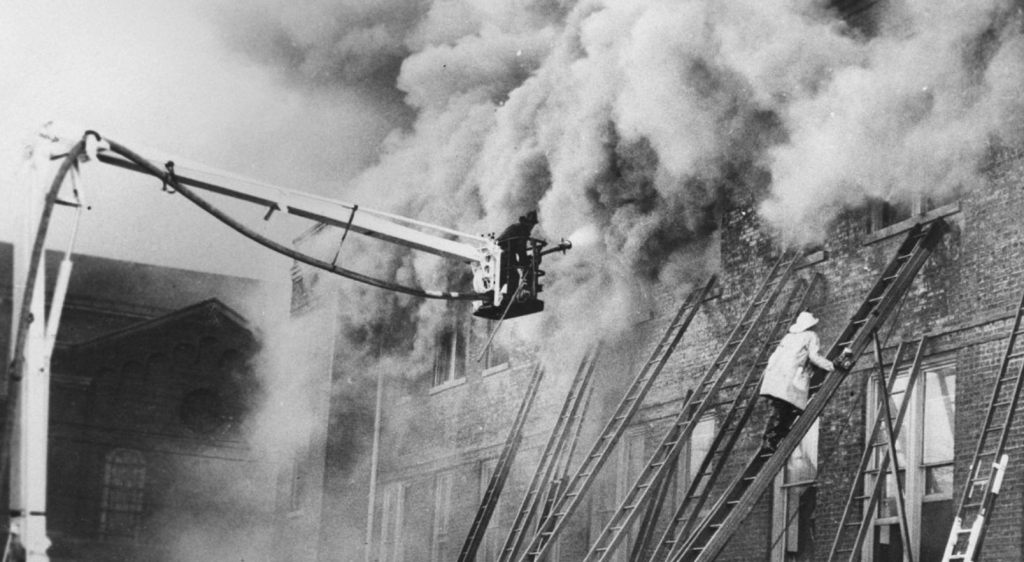It’s pretty easy to downplay the danger associated with fires because most of them get put out before they turn into catastrophes. While it’s not uncommon to hear about fire-related deaths in the news, they are linked to a very small percentage of fires that occur throughout any given year. Part of the reason that we’ve been able to keep devastating fires at bay is that we have excellent fire departments. We also place an emphasis on prevention, and people also have a basic awareness of common-sense fire safety practices.
Let’s take a look at a few historical fires that have helped to usher in the modern era of fire safety. They are also good illustrations of the catastrophic impact that fires can have if those safety measures aren’t in place.
1911 New York Garment Factory Fire
A massive fire engulfed a garment factory that occupied the top few floors of a 10 story building. The fire started in a pile of fabric on one of the floors before quickly spreading throughout the factory. Around 120 people were killed in the fire despite the fact that it only took firefighters about 20 minutes to extinguish the blaze.
It is unclear what started the fire, but some people suspect that careless smoking was the culprit. It was common for people to smoke at their work stations and discard butts into waste bins that would then smolder. Buckets of water were placed throughout the building to extinguish these fires when they cropped up.
Aside from that, few fire extinguishers were in the building, many of the doors and windows were locked to prevent employees from stealing clothing or material, and there were too many people inside as well. All of these factors contributed to the rapid spread of the fire as well as causing so many people to become trapped. In its wake, new labor and fire-safety laws were enacted, and the fire department developed its first prevention and inspection offices.
1944 Hartford Circus Fire
About 6800 people were under the big top when a small fire broke out along one of the sidewalls of the tent. Within minutes, the fire engulfed most of the tent as well as the wooden chairs inside. The few entrances and exits that existed were barricaded by rails and turnstiles to keep people without tickets from sneaking into the show. About 170 people died, and hundreds more were injured in the stampede for the exits.
It is thought that careless smoking started the rapidly-spreading fire. The tent material was saturated in wax and oil to make it waterproof, and flaming bits of material rained down on the spectators. Another contributing factor was that people were slow to react because they assumed that someone was aware of the situation and dealing with it.
One of the biggest changes to occur is that circuses started to use buildings and arenas instead of tents for their shows, and rules were put into place regarding emergency exits.
1958 Chicago School Fire
One of the most tragic school fires in history occurred at the Our Lady of Angels school in Chicago. It’s thought that an arsonist started the fire by igniting rags near barrels of flammable material in the basement. Because the school was private and not public, it was not bound by the same fire regulations that govern public buildings. There were no fire sprinklers, the building was littered with improperly-stored materials, virtually everything inside was combustible, fire extinguishers were stored out of easy reach, and the fire alarm wasn’t linked to the local fire station. There was also only one fire escape.
As the fire rapidly-spread, many who couldn’t escape fled to the second floor and became trapped by heat and smoke. The fire department was late to respond because they were given the wrong address, and when they arrived, the ladders on many of the fire trucks weren’t tall enough to reach the second floor. Nearly 100 people died in the blaze, but the aftermath ushered in sweeping fire-safety reforms for schools across the country.
2003 Rhode Island Club Fire
Some of you may remember the fire that erupted at The Station club where the heavy metal band White Lion was performing in front of a packed house. The fire broke out after an indoor pyrotechnic show went horribly wrong, and flames from the explosives ignited foam material behind the stage. People panicked and created a stampede as they tried to make their way to the only exit. People became trampled, the exit became blocked, and more than 100 died as a result.
The two biggest changes that occurred after this fire was that rules were tightened regarding the use of pyrotechnics indoors, and older buildings are now required to have sprinkler systems.
All of these fires had one thing in common: They were accidents waiting to happen. This is why prevention is so important, and it’s also important that we never take fire safety for granted. Take some time to evaluate what kind of fire risks exist in your home, and take steps to reduce them as much as possible. Make sure that you have a good escape plan in place as well, and that you practice fire-drills every now and then so everyone knows what to do if a fire breaks out. The more you can do to prevent a fire will minimize risk while knowing what to do during a fire can save your life.

